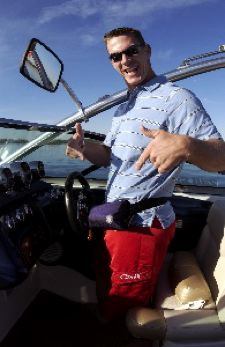Travel News
Boating Safety Basics
 If you missed Peter’s Today show segment on boating safety, we’ve got the scoop for you.
If you missed Peter’s Today show segment on boating safety, we’ve got the scoop for you.
With the Fourth of July right around the corner, the topic of boating safety is once again on the radar. Statistically, this holiday is considered to be one of the busiest, and often most deadly, dangerous boating weekends of the year.
As Peter reported, you might be surprised to learn that more people die every year in boating accidents than in trains or buses.
We’ve updated this article with fresh statistics and prices. Check it out here: Boating Safety Basics Updated.
According to the U.S. Coast Guard, more than 72 million people boat annually in the U.S. in hundreds of millions of outings–last year, there were nearly 5,000 boating accidents, resulting in 710 deaths. Due to the volume year-round boating, the highest number of casualties in took place in Florida, California and Texas.
Here are some basic facts on boating safety and what you can do to protect yourself this holiday weekend.
PERSONAL FLOTATION DEVICES
According to Virgil Chambers, executive director of National Safe Boating Council, last year, approximately 70 percent of all fatal boating accident victims drowned (491 out of 697). Moreover, 87 percent of the victims who drowned were not wearing their personal flotation device. Fatal accident data show approximately 426 lives could have been saved last year if boaters had worn their lifejackets.
“People need to know that there are truly wearable lifejackets out there,” explains Chambers. “The new lifejackets are more like belt packs or over the shoulder life packs. I can identify with the fact that the old orange lifejackets are cumbersome…they’re hot, they’re geeky.”
 You can see the inflatable belt pack in the photo at left … see the little bag around the guy’s hip? That’s it.
You can see the inflatable belt pack in the photo at left … see the little bag around the guy’s hip? That’s it.
The jacket is rolled up inside the bag, and boaters can simply slip it over the head and pull a tab to inflate it. It’s that simple.
For more information on personal flotation devices, visit the Coast Guard’s Web site at USCG Boating.
You can learn about the National Safe Boating Council’s “Wear It” campaign at Safe Boating Council.org.
EQUIPMENT ON BOARD
Besides life jackets, there are several other items that you should keep on board to ensure your safety. Petty Officer Dana Warr, spokesperson for the U.S. Coast Guard explains what equipment you should have on board with you:
Electronic Position Indicating Radio Beacon (EPIRB)
These come in two different forms: One is permanently fixed to your vessel, so that as the vessel sinks, the pressure is designed to deploy four feet under water. The beacon gives off a satellite signal, which notifies the Coast Guard of the vessel’s exact GPS location, the owner, type of vessel, length and registration address. These devices can cost between $200 and $1,500. If you’re operating in rivers, small lakes or bays, you probably don’t need this. Boating in the Great Lakes or the ocean? A necessity.
The Personal EPIRB is a compact beacon that you can attach directly to your body. It’s often used by fishermen but can also come in handy for yachters and small boat cruisers. The beacon will also alert the Coast Guard your location and indicate that you’re in a life-threatening emergency. A personal beacon can start at $100 and go up to about $700.
Our advice? Consider this one of those situations in which it’s worth spending a few extra dollars. West Marine, for example, sells a manual release EPIRB for $1,099 and an automatic release for $1,399. (There is a $189 EPIRB available, which is recommended more as a backup than your primary safety device.) A personal locator device is available at West Marine for $599-$699.
Marine VHF Radio
A marine VHF radio is already installed on motorized small crafts. It can be used to communicate with rescue services and other officials. The frequency range is 156 to 174 MHz. Channel 16 at 156.8 MHz is the standard international emergency channel. “The Coast Guard monitors it 24/7,” says Warr. “It’s reserved for maydays and it’s irresponsible to use Channel 16 for anything but emergencies.”
Cell Phone
“A cell phone is always a good thing, but it’s an alternate source of communication,” explains Warr. They may not work when you’re out in the water, but “if you get in trouble within a couple of miles of inland, you can use it for emergencies.” You can dial 911 to get your call transferred to the Coast Guard.
Lifejackets
Having lifejackets for each person on the vessel is non-negotiable. The trick is that the jackets need to be properly fitted. “If you put an adult-sized life jacket on a 9 year old, it will slide right off. If he’s unconscious, he’ll probably sink to the bottom.”
Sound-producing device
A whistle or a horn can be used to alert passersby if your boat gets in trouble. The whistle or horn should be capable of producing a sound that can be heard for at least a half mile.
Flares
Although not required for certain sized vessels, these are good to have onboard if you’ve transiting at night.
Signaling device
A basic mirror can be great for signaling passersby-no batteries needed (although sunlight is usually required).
For more information on boating safety equipment, visit the Coast Guard Web site at USCG Boating.
BOATING UNDER THE INFLUENCE (BUI)
It’s not something to take lightly. BUI is just as harmful and dangerous as drinking and driving a car on the roads. In fact, alcohol use was directly or indirectly related to about one-quarter of all boating fatalities in 2005.
You already know that drinking can affect your judgment, vision and sense of balance. However, the U.S. Coast Guard explains that alcohol can be even more hazardous on the water—the combination of the boat’s movement, sun, wind and sprays of water can impair you even further.
Both the Coast Guard and each state have penalties for violating laws against boating under the influence. You may be faced with hefty fines, a suspension or termination of your boat operator privileges, or even jail. The Coast Guard and every state have stringent penalties for violating BUI laws. Whether you are charged with state or federal law depends on the waters where you’re apprehended.
For tips on avoiding BUI, visit USCG Boating.
BOATING SAFETY CERTIFICATION
Now here’s a scary number: According to the Coast Guard, in 2005, approximately 70 percent of all reported fatalities occurred on boats where the operator has not received boating safety instruction.
Boating safety certification is a state-approved course for boaters. But it is NOT a license, it is a certification, which means that it is valid for a lifetime and can’t be taken away from you. Most boating safety certification tests indicate that you know the laws and regulations of boating, and you must carry your card with you while operating a vessel. Depending on the state, courses may require a certain number of in-class hours, an online course, or home study with DVD education, followed by a final test.
Each state varies with its boating safety certification requirements, and some of them are downright scary. In California and Wyoming, for example, there are no requirements. In Kentucky, kids as young as 12 can operate motorized vehicles if they are certified OR if they’re accompanied by someone who is 18 or older and is certified.
The states that lead the nation in terms of outreach and implementation of boating certification and training are currently Minnesota and Oregon.
To see a list of regulations by state, visit the National Association of State Boating Law Administrators.
To see online courses and sample boating certification tests, visit BoatEd.com
Want more boating info? Find out how to get Cheaper Chartered Boats.
Or try a different sort of boat trip … Eco-Boating: Floating Green.












